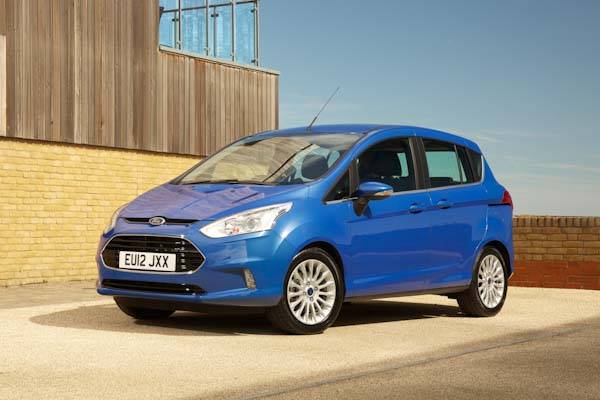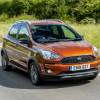
RAC sale – up to 33% off*
• Roadside cover from £5.29 a month†
• We get to most breakdowns in 60 mins or less
• Our patrols fix 4/5 breakdowns on the spot

By Jonathan Crouch
Introduction
Is there any point in a People Carrier if it's a really small one? It's a fair question that supermini-MPV models in the Nissan Note, Citroen C3 Picasso and Vauxhall Meriva segment have often struggled to answer. When Ford's B-MAX was launched in 2012, we at last got a credible response to that query, its unique design and unrivalled versatility offering more ways to use a car of just 4m in length than you might ever have thought possible.
Models
5dr MPV (Petrol - 1.4 / 1.0 EcoBoost 100 & 125PS [Diesel - 1.5 TDCi 75PS / 1.6 TDCi 90PS]
History
The smallest sort of people carrier evolved in the 21st century's second decade. In the Noughties, we had so-called supermini-MPVs, cars like Nissan's Note, slotting in below compact Scenic and C-MAX-sized designs, but usually, they offered little more than a slightly pumped-up take on the usual small car theme. New brands entering this segment needed to try harder. So we saw Citroen re-define the amount of space this kind of car could provide with their rounded but squerical C3 Picasso, Skoda offer us more avant garde styling with their Roomster and Vauxhall deliver rear doors that open the opposite way out in their Meriva. Interesting though these various approaches were, none of them really advanced the small people carrying proposition very far. But here's a car that did; Ford's B-MAX.
Launched here in the Autumn of 2012, it scores on its doors, but in a very different way to any of its rivals. This was the first car of this kind to use sliding side doors and, more uniquely still, the first to do away completely with a central B-pillar so that with the front door open, there's an enormous 1.5m of cabin aperture width, stretching all the way from windscreen to rear hatch. A far more innovative design than the Blue Oval bought us with this car's direct predecessor, the Fusion. And there's equal brilliance beneath the bonnet, with the option of a three cylinder 1.0-litre EcoBoost petrol engine that provides a decent alternative to diesel. The idea was to attract the kind of buyer who wants the versatility of a larger C-MAX-style compact MPV but needs something easier to park and cheaper to run. The B-MAX sold steadily until it was discontinued in 2018.
What You Get
Imagine the effect of shrinking Ford's large S-MAX people carrier in a hot wash and, if you're familiar with that model, you'll get a mental picture of, well, pretty much what we have here, a design 11cms longer than a Fiesta from this era but 32cms shorter than the C-MAX, the next model up in Ford's people carrying hierarchy. This design uses Ford's 'Kinetic' design 'language' and by and large, the stylists did a pretty effective job in disguising what has to be an awkward shape, with its short wheelbase and tall body.
There's plenty to distract your attention from that anyway, with unique B-MAX touches wherever you look. The Aston Martin-like front grille might be the first distinguishing feature you notice but more important of course is the issue that dominates discussion every time talk turns to this car: the doors. The front ones open normally but the back ones slide aside on cleverly concealed runners, so parents need have no more worries about their offspring re-sculpting the side of adjacent parked cars in tight supermarket spaces.
And with the side doors open, you're ready to admire this car's party piece: the absence of the kind of centre B-pillar that almost every other car in the world has to have for structural rigidity. Here, that same stiffness is provided by the edges of the doors themselves when they shut tightly together, clamping themselves against the body. What this ingenious piece of so-called 'Easy Access' design creates is a car that's incredibly easy for anyone of any age to get in and out of. And get things in and out of. With both side doors open, there's a 1.5m-wide aperture, into which you can slide items of up to 2.34m in length if you've taken up the option of folding flat the front passenger seat. IKEA flat packs? No problem. Bicycles? Yes, they'll go in from the side too.
Of course, most of the time, you'll still be loading stuff like that in through the boot. Though bigger than that of a rival Nissan Note, this is, at 318-litres, about 15-20% smaller than most other obvious supermini-MPV rivals, but you can make the most of the space you have by specifying a load area organiser that'll separate your eggs from your Iron Bru. Standard is an adjustable load floor that you can set to create a completely level loading area for when you push forward the split-folding rear bench (with a simple 'one hand-one motion' action) to reveal up to 1386-litres of total fresh air.
This car though, has primarily been packaged for people - and the lives they lead. Thanks to the pillar-less Easy Access system, it's simplicity itself to lean in and install a child seat or to help in an aging relative. Once inside, there's an airy feel, even if you don't opt for the full-length panoramic glass roof. More importantly, despite the diminutive 1.8m width, you can just about accommodate three adults across the back seat who'll have more head, leg and knee room than they would enjoy in most rivals, despite the lack of the sliding rear seats that some of those competitors offer.
Children of course, who're less likely to complain about the lack of a central arm rest, will be the more likely occupants - which might lead you to wonder about safety issues should the car start off with one of the sliding doors not fully shut. It is an issue: the doors, after all, are heavy things weighing about 55lbs and will crash shut with some force if left loose before sudden sharp braking. But there's a loud warning alarm that'll alert the driver way before this happens and in any case, a responsible parent would have his or her children strapped firmly in at this point.
And up front? Well, with an overall vehicle height that's 12cm higher than a Fiesta, you get all the benefits of what Ford calls a higher 'command' seating position. The seatbelt here has of course to be anchored to the seat itself, there being no B-pillar behind your right shoulder to attach it to. From this pleasingly prominent position with its height and reach steering wheel adjustability, you marshal the controls of a dashboard that's easy to operate if you speak fluent Ford. In front of you, there's a twin-dial instrument binnacle topped with lovely soft-touch plastic that contrasts with the harder, scratchier surfaces on the door tops, the glovebox and the centre console. At least build quality from the Romanian factory seems solid.
Ascend the range and there's a huge difference in cabin ambience, from the plainness you get at entry-level to the plush feeling of top models who've niceties like a ritzy Sony-branded eight-speaker stereo system. Distinctive features include the slim, wing-like section of the upper instrument panel which reaches out to the door panels. And the prominent centre console, which flows down between the front seats. As for storage space, well a rubberised slot to park your smart 'phone in would have been a useful addition but otherwise, all the usual nooks and crannies are provided.
What You Pay
Please fill in the form here for an exact up-to-date information.
What to Look For
We came across plenty of satisfied B-MAX customers but there were also a number of rogue examples, with issues that buyers on the used market will need to look out for. we came across plenty of electrical issues. One customer found that his car needed to be used every other day, otherwise it wouldn't start due to battery drain. There were also lots of complaints about the auto gearbox, so be very careful when it comes to that. One owner said that this gearbox 'judders and rattles like a box of screws'. What else? Well on one car, the front windscreen defrost mechanism failed and the car exhibited an annoying judder between 15 and 25 mph when not accelerating hard. The battery earth cable also failed on that particular example, bringing the car to an immediate halt with the gears jammed (a fault identified as a broken/sheared cable at the point the cable meets the connector, suggesting that this was a manufacturing fault).
Another owner complained that his driver's seat was faulty; it had a lot of play in it and rocked backwards and forwards. Some owners have reported issues with the stereo system and the ventilation set-up, so check these out thoroughly before you buy. As usual, check that the service book is fully stamped up to date. Some ex-fleet models may have missed out on garage visits.
Replacement Parts
(approx based on a 2013 B-MAX 1.0 EcoBoost - Ex Vat) An air filter costs around £10-£13 and an oil filter costs around £6-£8. Brake pads sit in the £28 to £40 bracket for a set. Front brake discs can be as affordable as around £60, though we found pricier branded items costing around £78. Wiper blades cost in the £10 bracket. A timing belt costs in the £35 to £45 bracket, while a water pump costs in the £68 to £75 bracket. A fuel pump can be had for around £102. Car batteries vary in price according to numerous factors.
On the Road
Ford models are generally great to drive and most of the reason why is found in one thing: chassis stiffness. Take that away and you neutralise one of the Blue Oval's strongest selling points. But isn't that exactly what's happened with this B-MAX? With no central B-pillar, you'd expect the whole structure to be flexing all over the place. You'd expect a driving disappointment. But, as you'll find out once on the move, you don't get it.
We suppose it's easy to be impressed when you start with such low expectations but this thing really does confound all your preconceptions. It's a people carrier for a start and worse, one with sliding doors, previously a sure-fire recipe for dynamic dullness in any car you care to name. Yet as soon as you get going, this Ford feels frisky, even fun: certainly feelsome in the way it responds to the way you want to drive. Of course it helps here that the basics are right. You sit quite high up, positioned far more commandingly than you would be in a Fiesta with everything you need perfectly placed around you. And at speed, all-round visibility's great.
As for that B-pillar business, well forget it. It's not that there isn't one: it's just that you can't see it. Clever design has integrated the central pillar structure into the leading edges of the front and rear doors where they come together. When they're shut, they clamp themselves to the body very tightly and become part of the stiffness of the car. So much so in fact that this B-MAX can actually boast a stiffer structure than that of the Fiesta supermini upon which it's based.
And a stiffer ride too? Well actually no. In fact, the ride quality is one of the very best things about this car, which is all the more remarkable given that the engineers didn't have anything too exotic to work with. There's a suppleness to the suspension which strikes a better balance here than in anything else Ford makes, soaking up terrible town tarmac, yet firm enough to keep body roll well controlled through twisty roads you'll enjoy yourself on thanks to the standard torque vectoring system that helps corner turn-in and accurate, well-weighted electric power steering. It's no Ford Focus - the tall shape can't be as well tied down as a conventional hatch would be - but we'd go as far as to say that new standards were set here for supermini-MPVs in the ride and handling department.
Which is something of an accolade for a car that's really designed for an urban environment, a place where suddenly the B-MAX starts to make all kinds of sense. For a start, you get the sort of view out of the car that's denied to a typical supermini driver, so you can spot jams forming a long way ahead and, if necessary, reroute. It's not too wide either, so you can nudge it between width restrictions, zip through tight gaps in the traffic and sidle into multi storey bays that would be difficult or impossible in a bigger vehicle. Once in them though, the front and rear extremities of the car can be a little hard to judge, making the optional parking camera package a worthwhile investment.
And under the bonnet? Well there's nothing too impressive at the bottom end of the range, where the choices on offer remind you of the way Ford technology used to be. These include a labouring 90PS petrol 1.4 that props up the line-up and an auto-only 105PS petrol 1.6-litre variant that's mainly there for older or disabled buyers. Inevitably, the engines you'd really want are the pricey ones further up the range and if the price being asked enables you to afford one of them, then there's plenty to admire, most notably when it comes to consideration of the cleverest petrol powerplant on the planet, Ford's clever 1.0-litre EcoBoost unit, complete with its distinctive three cylinder thrum and offered to B-MAX buyers with either 100 or 120PS.
We first saw this fitted to the larger Focus family hatch and though here, it's accessible via a gearbox with five rather than six speeds, it's still a mighty impressive piece of kit, the higher powered variant combining an eleven second 0-60mph time with nearly sixty miles to the gallon and a clean-fingered 114g/km CO2 return. Alternatively, there's the 75PS 1.5-litre diesel developed for use across all of Ford's small car offerings, frugal and clean but somewhat slow, rest to sixty occupying nearly 17s. A better combination of virtues is offered by the 95PS 1.6-litre TDCi unit, an engine that gets this car to sixty in 13.9s on the way to 108mph and offers a bit more all-round performance punch.
Overall
It's a tad ironic given the name that Ford's B-MAX is missing very little - apart from its B-pillar. Were it not for that, this would have been a smart, carefully thought out but generally unremarkable addition to a supermini-MPV segment the Blue Oval had previously never properly addressed. As it was, this one stroke of design genius set this model apart and established it as a class leader.
We've long known that for many modern families, ultimate space is less important than versatility, a fact underlined here by the ease with which this pillar-less design makes loading and unloading of both people and packages so much more straightforward. Of course, we've had cars designed around doors before: few of them had much else to offer. Here though, it's different. Decent safety, the SYNC connectivity system's cleverness and three cylinder EcoBoost engine technology that delivers petrol power with diesel returns: all these things make this model a strong player in its segment. Other supermini-MPV rivals from the 2012-2017 era might be slightly bigger or more affordable but if you can find a good one, in this Ford you've what for us is the perfect growing family's second car. And finally, a small people carrier that makes perfect sense.





![BMW 2-Series Active Tourer [F45] (2018 - 2021) used car review](https://d1ix0byejyn2u7.cloudfront.net/drive/images/made/drive/images/remote/https_d2yv47kjv2gmpz.cloudfront.net/filestore/1/8/5_1779ec7cdbdbe42/dbf8ce253aa50a487d3ca251f107c3a4/581_fac06c296168439_100_100_70_c1_c_c.jpg)
![Ford Focus Estate [C170] (2002 - 2005) used car review](https://d1ix0byejyn2u7.cloudfront.net/drive/images/made/drive/images/remote/https_d2yv47kjv2gmpz.cloudfront.net/filestore/6/4/2/1_d4d8db0c84d4b6d/1c426a9b430a095acc69a66065c76811/1246_29e3bc2784b2468_100_100_70_c1_c_c.jpg)
